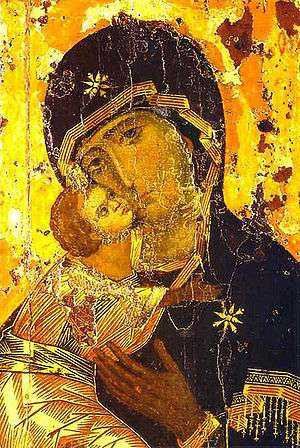Titles of Mary

Mary is known by many different titles (Blessed Mother, Madonna, Our Lady), epithets (Star of the Sea, Queen of Heaven, Cause of Our Joy), invocations (Theotokos, Panagia, Mother of Mercy) and other names (Our Lady of Loreto, Our Lady of Guadalupe).
| A series of articles on |
| Mother of Jesus |
| Chronology |
|---|
|
|
| Marian perspectives |
|
|
| Catholic Mariology |
|
|
| Marian dogmas |
|
|
| Mary in culture |
|
|
All of these titles refer to the same individual named Mary, the mother of Jesus Christ (in the New Testament) and are used variably by Roman Catholics, Eastern Orthodox, Oriental Orthodox, and some Anglicans. (Note: Mary Magdalene, Mary of Clopas, and Mary Salome are different individuals from Mary, mother of Jesus.)
Many of the titles given to Mary are dogmatic in nature. Other titles are poetic or allegorical and have lesser or no canonical status, but which form part of popular piety, with varying degrees of acceptance by the clergy. Yet more titles refer to depictions of Mary in the history of art.
Historical and cultural context
There are several stories on the significance of the relatively large number of titles given to Mary.[1][2] Some titles grew due to geographic and cultural reasons, e.g. through the veneration of specific icons. Others were related to Marian apparitions.
Mary's help is sought for a large spectrum of human needs in varied situations. This led to the formulation of many of her titles (good counsel, help of the sick, etc.). Moreover, meditations and devotions on the different aspects of the Virgin Mary's role within the life of Jesus led to additional titles such as Our Lady of Sorrows.[3] Still further titles have been derived from dogmas and doctrines, such as the Immaculate Conception.
Mary's cultus or "devotional cult" consolidated in the year 431 when, at the Council of Ephesus, the Theotokos, or Mary as bearer (or mother) of God, was declared dogma. Henceforth Marian devotion—which centered on the subtle and complex relationship between Mary, Jesus, and the Church—would flourish, first in the East and later in the West.
The Reformation diminished Mary's role in many parts of Northern Europe in the 16th and 17th centuries. The Council of Trent and Counter Reformation would intensify Marian devotion in the West. Around the same period, Mary would become an instrument of evangelization in the Americas and parts of Asia and Africa, e.g. via the apparitions at Our Lady of Guadalupe which resulted in a large number of conversions to Christianity in Mexico.
Following the Reformation, as of the 17th century, the baroque literature on Mary experienced unforeseen growth with over 500 pages of Mariological writings during the 17th century alone.[4] During the Age of Enlightenment, the emphasis on scientific progress and rationalism put Catholic theology and Mariology often on the defensive in the later parts of the 18th century, to the extent that books such as The Glories of Mary (by Alphonsus Liguori) were written in defense of Mariology.
Dogmatic titles
- Mother of God: The Council of Ephesus decreed in 431 that Mary is Theotokos because her son Jesus is both God and man: one Divine Person with two natures (Divine and human).[5] This name was translated in the West as "Mater Dei" or Mother of God. From this derives the title "Blessed Mother".
- Virgin Mary: The doctrine of the perpetual virginity of Mary developed early in Christianity and was taught by the early Fathers, such as Irenaeus, Clement of Alexandria, and others.[6] In the fourth century "ever-virgin" became a popular title for Mary.[7] Variations on this include the "Virgin Mary", the "Blessed Virgin", the "Blessed Virgin Mary", and "Spouse of the Holy Spirit". The perpetual virginity of Mary was declared a dogma by the Lateran Council of 649.
- Immaculate Conception: The dogma that Mary was conceived without original sin was defined in 1854, by Pope Pius IX's apostolic constitution Ineffabilis Deus. This gave rise to the titles of "Our Lady of the Immaculate Conception" and "Queen Conceived Without Original Sin". The Immaculate Conception is also honored under the titles of Our Lady of Caysasay (Philippines),[8] Our Lady of the Gate of Dawn in Vilnius, Our Lady of Guidance, and Our Lady of Salambao, also in the Philippines.
- Assumption: The belief that the Virgin Mary having completed the course of her earthly life, was assumed body and soul into heaven was declared a dogma in 1950 by Pope Pius XII in the apostolic constitution Munificentissimus Deus. The titles "Our Lady of Assumption" and "Queen Assumed Into Heaven" derive from this. This dogma is also reflected in devotion to Our Lady of Ta' Pinu on Malta.
Early titles of Mary
“Our Lady” is a common title to give to Mary as a sign of respect and honor. In French she is called "Notre Dame" and in Spanish she is "Nuestra Señora".[9]
- Mary was identified as the "New Eve" as early as the later half of the Second Century. Justin Martyr (100–165) draws the connection in his Dialogue with Trypho. This idea is later expanded by Irenaeus.[10]
- John Chrysostom, in 345, was the first person to use the Marian title Mary Help of Christians as a devotion to the Virgin Mary. Don Bosco promoted devotion to Mary under this title.
- Stella Maris or Our Lady, Star of the Sea is an ancient title for the Virgin Mary, used to emphasize her role as a sign of hope and a guiding star for Christians. It is attributed to Jerome and cited by Paschasius Radbertus.
| English | Latin | Greek | Notes |
|---|---|---|---|
| Mary | Maria | Mariam (Μαριάμ), Maria (Μαρία) | Arabic: Maryām (مريم), Chinese: (瑪利亞), Coptic: Mariam, French: Marie, German: Maria, Italian: Maria, Judeo-Aramaic: Maryām (מרים), Maltese: Marija, Portuguese: Maria, Russian: Marija (Мария), Spanish: María, Syriac: Mariam, Vietnamese: Maria |
| "Full of Grace", "Blessed", "Most Blessed" | Gratia plena, Beata, Beatissima | kecharitomene[11] (κεχαριτωμένη) | from the angel's greeting to Mary in Luke 1:28; |
| "Virgin", "the Virgin" | Virgo | Parthenos[12][13] (Παρθένος) | Greek parthenos used in Matthew 1:22; Ignatius of Antioch refers to Mary's virginity and motherhood (ca. 110); |
| "Cause of our Salvation" | causa salutis[14] | according to Irenaeus of Lyons (150–202); | |
| "Mother of God" | Mater Dei | Meter Theou (Μήτηρ Θεοῦ) | often abbr. ΜΡ ΘΥ in Greek iconography; |
| "God-bearer" | Deipara, Dei genitrix | Theotokos (Θεοτόκος) | lit. "one who bears the One who is God"; a common title in Eastern Christianity with christological implications; adopted officially during Council of Ephesus (431) in response to Nestorianism, which questioned the Church's teaching that Jesus Christ's nature was unified; |
| "Ever-virgin" | semper virgo | aei-parthenos[12] (ἀειπάρθενος) | |
| "Holy Mary", "Saint Mary" | Sancta Maria | Hagia Maria[12] (Ἁγία Μαρία) | Greek invocation is infrequent in contemporary Eastern Christianity;[2] |
| "Most Holy" | Sanctissima, tota Sancta[15] | Panagia (Παναγία) | |
| "Most Pure" | Purissima | ||
| "Immaculate" | immaculata | akeratos[12] (ἀκήρατος) | |
| "Lady", "Mistress" | Domina | Despoina[12] (Δέσποινα) | related, "Madonna" (Italian: Madonna, from ma "my" + donna "lady"; from Latin domina); also, "Notre Dame" (French: Notre Dame, lit. "our lady"); |
| "Queen of Heaven" | Regina Coeli, Regina Caeli | Mary is identified with the figure in Revelation 12:1; | |
Papal actions
- After the Battle of Lepanto in 1521, Pope Pius V instituted the feast of the Blessed Virgin Mother of Victory.
- During World War I, Pope Benedict XV added the invocation Mary Queen of Peace to the Litany of Loreto.
- In 1960 Pope John XXIII changed the title of the Feast of the Holy Rosary (formerly the Feast of Our Lady of Victory) to the "Feast of Our Lady of the Rosary.
Descriptive titles of Mary related to visual arts
| Image Type | Typical Art Style | Description |
|---|---|---|
 Hodegetria |
Byzantine | Mary holds Christ in her left hand and with her right hand she "shows the way" by pointing to Him; |
 Sedes Sapientiae |
Romanesque | Christ is seated in His mother Mary's lap, symbolically the "Throne of Wisdom"; |
 "Gothic Madonna" |
Gothic | Based loosely on Byzantine Hodegetria iconography; typically depicts a standing, smiling Mary and playful Christ Child; considered one of the earliest depictions of Mary that is strictly Western;[16] |
 Madonna Lactans |
Gothic and Renaissance | The Virgin is depicted breastfeeding the Holy Infant. One of the earliest depictions (if not the earliest depiction) of Mary, is Our Lady nursing, as painted in the Catacomb of Priscilla in Rome, c. A.D. 250;[17] Discouraged by the Council of Trent and rare subsequently. |
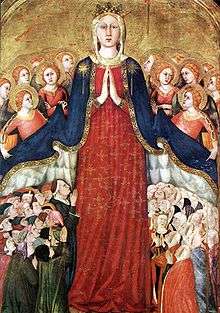 Mater Misericordiae |
Gothic, Renaissance, Baroque | A regal, celestial Mary is depicted covering the faithful in her protective mantle; first arose in the late 13th century in Central Europe and Italy; depiction is commonly associated with plague monuments.[18] |
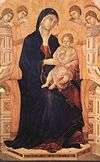 Maestà |
Gothic | Mary is seated in majesty, holding the Christ Child; based on Byzantine Nikopoia iconography; |
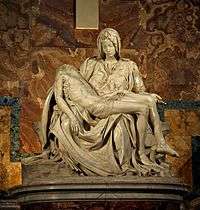 Pietà |
Gothic, Renaissance, Baroque | Mary cradles the dead body of Jesus Christ after his crucifixion; this type emerged first in the 13th century in Germany as an Andachtsbild or devotional icon relating to grief; Italian Pietàs appeared in the 14th century;[19] Michelangelo's Pietà (1498–1499) is considered a masterpiece; |
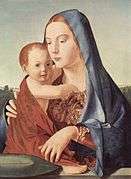 Mater Amabilis |
Renaissance, Baroque | Iconic Western depiction with many variations; based loosely on Byzantine Glykophilousa ("sweet kisses") iconography; Mary turns her gaze away from the Christ Child as she contemplates His future Passion; Renaissance emphasis on classical ideal types, realistic human anatomy, and linear perspective are evident; |
Devotional titles
In the Loreto Litanies Mary's prayers are invoked under more than fifty separate titles, such as "Mother Most Pure", "Virgin Most Prudent", and "Cause of Our Joy".[20]
Other devotional titles include:
- Ark of the Covenant
- Comfort of the Afflicted
- Gate of Heaven
- Health of the Sick
- Help of the Afflicted
- Holy Mary
- Holy Virgin of Virgins
- Immaculate Heart of Mary
- Morning Star
- Mother of Christ
- Mother of Mercy
- Mother of Sorrows
- Madonna Della Strada
- Mother of the Church
- Mystical Rose
- Our Lady of Bethlehem
- Our Lady of Charity
- Our Lady of Chartres
- Our Lady of Combermere
- Our Lady of Compassion
- Our Lady of Grace
- Our Lady of Lebanon
- Our Lady of Light
- Our Lady of Loreto
- Our Lady of Providence
- Our Lady of Ransom
- Our Lady of Solitude
- Our Lady, Star of the Sea
- Our Lady of Vallarpadam
- Queen of All Saints
- Queen of the Angels
- Queen of Apostles
- Queen of Confessors
- Queen of Families
- Queen of Martyrs
- Queen of Patriarchs
- Queen of Prophets
- Queen of Virgins
- Refuge of Sinners
- Salus Populi Romani (Salvation of the People of Rome)
- Tower of David
- Untier of Knots (also, Undoer of Knots)
Titles associated with devotional images
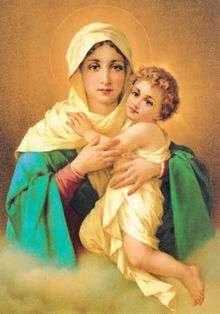
- A "Black Madonna" (or Vierges Noires) is a type of statue or painting, generally of the 12th to 15th centuries, in which Mary, and oftentimes the infant Jesus are depicted with dark features.[21] There are over 450 Black Madonnas in Europe. The title given to Mary, usually reflects the location of the image. The Black Madonna of Częstochowa, the Virgin of Candelaria, and Our Lady of Peace and Good Voyage are noted examples.
- Mother of Good Counsel (Latin: Mater boni consilii) is a title given to the Blessed Virgin Mary, after a painting said to be miraculous, now found in the thirteenth century Augustinian church at Genazzano, near Rome, Italy.
- Mother Thrice Admirable refers to Mary depicted in a painting as Our Lady Refuge of Sinners. Devotion to Mary as Mother Thrice Admirable is significant in the Schoenstatt Movement.
Other titles related to images include:
- Notre-Dame de Liesse
- Our Lady of Atocha[22]
- Our Lady of Covadonga
- Our Lady of Confidence
- Our Lady of Good Success
- Our Lady of Manaoag
- Our Lady of La Naval de Manila
- Our Lady of Nazaré
- Our Lady of Peace
- Our Lady of Peñafrancia
- Our Mother of Perpetual Help
- Our Lady of Piat
- Our Lady of Porta Vaga
- Our Lady of Prompt Succor
- Our Lady of the Rocks
- Our Lady of Turumba
- Santa Marian Kamalen (Guam)
- Our Lady of Korattymuthy (India)
Titles associated with apparitions
- Our Lady of Akita
- Our Lady of Banneux
- Our Lady of Beauraing
- Our Lady of Cabeza
- Our Lady of Caravaggio
- Our Lady of China
- Our Lady of Fátima
- Our Lady of Guadalupe
- Our Lady of Good Health
- Our Lady of Good Help
- Mother of the Word (Kibeho)
- Our Lady of Knock
- Our Lady of La Salette
- Our Lady of La Vang
- Our Lady of Laus
- Our Lady of Lourdes
- Our Lady of the Miraculous Medal
- Our Lady of Mount Carmel
- Our Lady of the Pillar
- Our Lady of the Snows
- Our Lady of Walsingham
- Our Lady of Zeitoun
Latin America
A number of titles of Mary found in Latin America pertain to cultic images of her represented in iconography identified with a particular already existent title adapted to a particular place. Our Lady of Luján in Argentina refers to a small terracotta image made in Brazil and sent to Argentina in May, 1630. Its appearance seems to have been inspired by Murillo's Immaculates. Our Lady of Copacabana (Bolivia): is a figure related to devotion to Mary under the title "Most Blessed Virgin de la Candelaria, Our Lady of Copacabana". About four feet in height, the statue was made by Francisco Tito Yupanqui around 1583 and is garbed in the colors and dress of an Inca princess.[23]
- Nuestra Señora de los Afligidos (Our Lady of the Troubled), Brazil[22]
- Nuestra Señora de la Anunciación (Our Lady of the Annunciation)[22]
- Nuestra Señora de la Asunción (Our Lady of the Assumption)
- Our Lady of Aparecida
- Our Lady of Carmel of the Maipú[23]
- Our Lady of the Rosary of Chiquinquirá
- Nuestra Señora de los Ángeles (Our Lady of the Angels), Costa Rica[23]
- Virgin of Suyapa (Honduras)
- Virgin of the Thirty-Three
Titles in the Orthodox Church
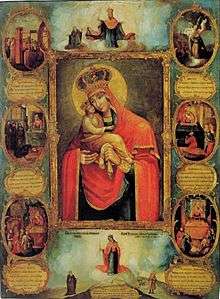
Theotokos means "God-bearer" and is translated as "Mother of God". This title was given to Mary at the Third Ecumenical Council in Ephesus in 431 AD.(cf. Luke 1:43).[24]
- Life-giving Spring
- Our Mother the Holy Virgin (John 19:27)[24]
- Our Lady of Kazan
- Our Lady of St. Theodore
- Panagia
- The Queen Who is by the Right Side of the King (from Ps.45:9)[24]
- Theotokos of Vladimir
Names and titles of Mary in Islam
The Qur'an refers to Mary by the following titles:
- Qānitah - the Arabic term implies the meaning, not only of constant submission to Allah, but also absorption in prayer and invocation.
- Siddiqah - "She who accepts as true" or "She who has faith". The term has also been translated "She who believes sincerely totally".
- Sājidah - "She who prostrates to Allah in worship"
- Rāki’ah - "She who bows down to Allah in worship"
- Tāhirah - "She who was purified"
- Mustafia - "She who is chosen"
- Nur - Mary has been called Nur (Light) and Umm Nur (the mother of one who was Light)
- Sa’imah - "She who fasts"
- Ma'suma - "She who never sinned"
See also
- Agni Parthene
- Intercession of the saints
- Litany of the Blessed Virgin Mary
- Marian apparitions
- Roman Catholic Mariology
- Veneration of Mary in Roman Catholicism
Citations
- ↑ Duricy, Michael P., "Why does Mary have so many different titles?", Marian Library. University of Dayton, October 26, 2010
- 1 2 The Titles of Saints, Orthodox Holiness, December 18, 2005
- ↑ Tavard, George Henry, The thousand faces of the Virgin Mary 1996 ISBN 0-8146-5914-4 p. 95
- ↑ Roskovany, A., conceptu immacolata ex monumentis omnium seculrorum demonstrate III, Budapest 1873
- ↑ by Braaten, Carl E. and Jenson, Robert W., Mary, Mother of God, 2004 ISBN 0802822665 p. 84
- ↑ Maas, Anthony. "Virgin Birth of Christ." The Catholic Encyclopedia Vol. 15. New York: Robert Appleton Company, 1912. 10 April 2016
- ↑ Wuerl, Donald W. and Stubna, Kris D., The Teaching of Christ: A Catholic Catechism for Adults, Our Sunday Visitor Publishing, 2004, ISBN 9781592760947
- ↑ "In Honor of Nuestra Señora de Guia", De AnDA (2009-11-22),
- ↑ Hargett, Malea. "Marian titles chosen for one out of four churches in diocese", Arkansas Catholic, Diocese of Arkansas, May 20, 2006
- ↑ Mauriello, Matthew R., "Mary, the New Eve", Marian Library, University of Dayton, August 3, 3009
- ↑ "...Byzantine inscriptions from Palestine...in the sixth [century]....fourteen inscriptions invoke "Holy Mary" (Hagia Maria), eleven more hail her as Theotokos; others add the attribution of "Immaculate" (Akeratos), "Most Blessed" (Kecharitomene), "Mistress" (Despoina), "Virgin" or "Ever-Virgin" (Aei-Parthenos)." (Frend 1984, p. 836)
- 1 2 3 4 5 Frend 1984, p. 836.
- ↑ "Blue Letter Bible" lexicon results for parthenos Retrieved December 19, 2007.
- ↑ Irenaeus of Lyons (Adversus Haereses 3.22.4).
- ↑ http://www.uni-mannheim.de/mateo/camenaref/hofmann/p/books/p_408.html
- ↑ Madonna. (2008). In Encyclopædia Britannica. Retrieved February 17, 2008, from Encyclopædia Britannica Online:
- ↑ http://www.catacombepriscilla.com/pagine-eng/regina.htm
- ↑ Jeep 2001, p. 393.
- ↑ Watts, Barbara. "Pietà". Grove Art Online. Oxford University Press, Retrieved February 17, 2008, http://www.groveart.com/
- ↑ "The Loreto Litanies". The Holy See. Retrieved 2011-11-07.
- ↑ "Black Madonnas--Introduction". udayton.edu.
- 1 2 3 "Titles of Mary", Regis University
- 1 2 3 "Latin American Titles of Mary", Las Advocaciones Marianas en la Religiosidad Popular Latinoamericana
- 1 2 3 "Titles of the Holy Theotokos, Saint Mary", Coptic Orthodox Church of Alexandria, Diocese of Los Angeles
References
- Frend, W. H. C. (1984). The Rise of Christianity. Fortress Press. ISBN 0-8006-1931-5.
- Jeep, John M. (2001). Medieval Germany: An Encyclopedia. Routledge. ISBN 0-8240-7644-3.
External links
- Archaeological project to collect all epithets of Mary in Greek, Latin, and Syriac
- List of 6,000 Catholic titles of Mary
- Roman Catholic understanding of Marian titles
- Eastern Orthodox understanding of saints' titles
- Raised to Heaven because Co-Redemptrix on earth. Thoughts on the foundation of the Catholic dogma. Lecture by Monsignor Brunero Gherardini. Explains the meaning of the Marian titles Assumpta, Mediatrix, Co-Redemptrix.
